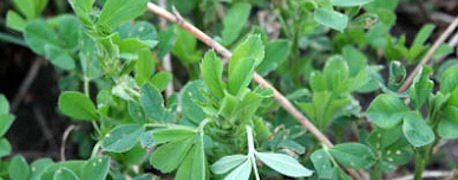May 8, 2013

Where alfalfa stands are terminated and planted to another crop, the alfalfa plant material can provide all of the nitrogen needed for a good corn crop on many loam type soils.
University of Minnesota Extension corn agronomist Jeff Coulter spoke at several meetings around Minnesota this winter about field trials conducted to study alfalfa nitrogen credits. Twenty-eight of 31 trials showed no response to nitrogen fertilizer for corn following an alfalfa stand that had 4-5 plants per square foot. Yields on many of these fields with adequate rainfall were in the 170- to 220-bushel per acre range.

Account For Alfalfa Nitrogen Credits
Three fields with loam soils that did show a response to nitrogen fertilizer had wet and cold soil conditions. It is thought that alfalfa plant material did not break down and release nitrogen sufficiently on these fields. In the 3 fields that responded to nitrogen fertilizer, 80 pounds of nitrogen applied before planting maintained optimum corn yields. On these same fields, 40 pounds of nitrogen applied as a side-dress application provided optimum corn yields. Appling less nitrogen in a side-dress application provided a cost savings and put less nitrogen in the environment. This might indicate that some of the 80 pounds applied before planting was lost through de-nitrification or leaching losses. If we continue with later and cooler wetter patterns, this might be a year when side-dressing 40 pounds of corn following alfalfa might be useful where soils stay wetter and cooler in the early part of the growing season.
In Minnesota, our standard guideline for nitrogen available following an alfalfa stand is that with 4 or more plants per square foot. There can be 150 pounds of nitrogen per acre the first year and 75 pounds the second year. With 2-3 plants per square foot there can be 100 pounds available the first year and 50 pounds the second year. With 1 plant per square foot, there can be 40 pounds of nitrogen available the first year and zero the second year.
It's good to learn from the experience you have on your own farm. In many situations, it's not difficult to run field trials to see whether additional nitrogen is helpful or not. It's helpful to have 2 or 3 replications of strip or small plot trials to get results that are more reliable. This helps to rule out other factors that might affect the results.
Some soil and water conservation districts have cost share funds for working with farmers on on-farm nutrient management field trials. Trials might relate to alfalfa credits, manure applications, or to other fertilizer practices. Crop consultants and farm store agronomy advisers are a good resource.
By Dan Martens, University of Minnesota Extension. Contact Martens at 800-964-4929.
Set The Schedule For Hay Quality. Deciding when to make the first cutting of hay sets the stage for the rest of the year. Download our FREE report 10 Hay Farming Basics: Producing A Quality Hay Product today.
You May Also Like




